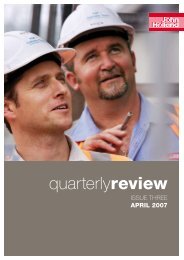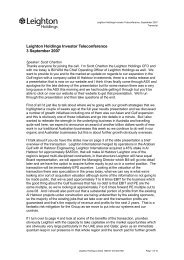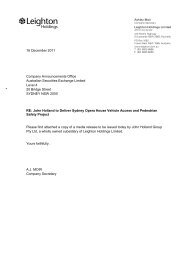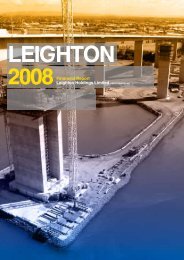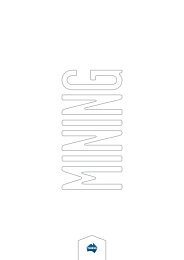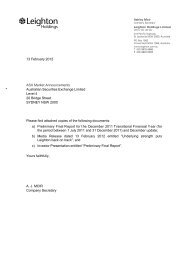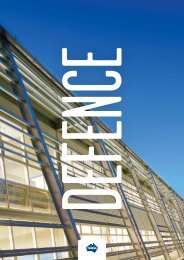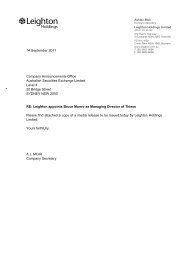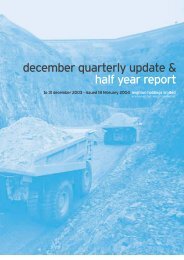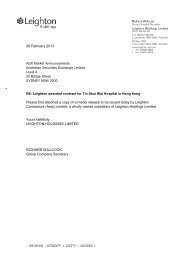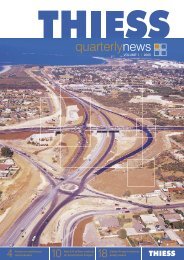Financial Report 2009 - Leighton Holdings
Financial Report 2009 - Leighton Holdings
Financial Report 2009 - Leighton Holdings
You also want an ePaper? Increase the reach of your titles
YUMPU automatically turns print PDFs into web optimized ePapers that Google loves.
Notes continued<br />
for the year ended 30 June <strong>2009</strong><br />
1. SUMMARY OF SIGNIFICANT ACCOUNTING POLICIES CONTINUED<br />
The contributions are payable as<br />
set out in the agreement and<br />
reflect the timing of the head<br />
entity’s obligations to make<br />
payments for tax liabilities to the<br />
relevant tax authorities. The<br />
assets and liabilities arising under<br />
the tax funding agreement are<br />
recognised as intercompany<br />
assets and liabilities with a<br />
consequential adjustment to<br />
current income tax.<br />
Inventories<br />
Inventories are carried at the<br />
lower of cost and net realisable<br />
value. Inventories comprise:<br />
Property developments<br />
Cost includes the costs of<br />
acquisition, development and<br />
holding costs such as rates, taxes<br />
and finance costs. Holding costs<br />
on property developments not<br />
under active development are<br />
expensed as incurred.<br />
Raw materials and consumables<br />
Cost is based on the first-in, firstout<br />
principle and includes<br />
expenditure incurred in acquiring<br />
the inventories and bringing them<br />
to their existing condition and<br />
location.<br />
Investments<br />
Controlled entities<br />
Investments in controlled entities<br />
are carried in the Company’s<br />
financial statements at cost less<br />
impairment.<br />
Equity accounted investments<br />
Investments in entities over which<br />
the Group has the ability to<br />
exercise significant influence but<br />
not control, and jointly controlled<br />
entities are accounted for using<br />
equity accounting principles.<br />
These investments are carried at<br />
cost plus post-acquisition changes<br />
in the net assets of the<br />
investment. The consolidated<br />
income statement reflects the<br />
Group’s share of the result of<br />
these investments. Where there<br />
has been a change recognised<br />
directly in equity, the Group<br />
recognises its share of that<br />
change.<br />
Property, plant and equipment<br />
Property, plant and equipment is<br />
stated at cost less accumulated<br />
depreciation and any impairment in<br />
value.<br />
Depreciation and amortisation<br />
Depreciation and amortisation is<br />
calculated so as to write-off the net<br />
book value of property, plant and<br />
equipment over their estimated<br />
effective useful lives as follows:<br />
• freehold buildings: straight line<br />
method - up to 40 years;<br />
• major plant and equipment:<br />
cumulative number of hours<br />
worked - up to 10 years;<br />
• major plant and equipment -<br />
component parts: cumulative<br />
number of hours worked - up to<br />
10 years;<br />
• leased plant and equipment:<br />
straight line method, over the<br />
terms of the leases - up to 10<br />
years;<br />
• waste management assets:<br />
straight line method, economic<br />
life of the waste operations - up<br />
to 20 years;<br />
• office and other equipment:<br />
diminishing value method - up to<br />
10 years;<br />
• leasehold buildings and<br />
improvements: straight line<br />
method, over the terms of the<br />
leases - up to 40 years.<br />
Subsequent costs<br />
Subsequent costs are included in<br />
the carrying amount of property,<br />
plant and equipment only when it<br />
is probable that the associated<br />
future economic benefits will flow<br />
to the Group. All other costs are<br />
recognised in the income<br />
statement.<br />
Leased assets<br />
Leases under which the Group<br />
assumes substantially all the risks<br />
and benefits of ownership are<br />
classified as finance leases. Other<br />
leases are classified as operating<br />
leases.<br />
Finance leases<br />
A lease asset and a lease liability<br />
equal to the lower of the fair value<br />
of the leased property and the<br />
present value of the minimum<br />
lease payments is recorded at the<br />
inception of the lease. The finance<br />
lease liability is the net present<br />
value of future finance lease<br />
rentals and residuals. Lease<br />
liabilities are reduced by<br />
repayments of principal. The<br />
interest components of the lease<br />
payments are expensed.<br />
Contingent rentals, which are<br />
potential incremental lease<br />
payments not fixed in amount as<br />
they relate to future changes, are<br />
expensed as incurred.<br />
Operating leases<br />
Payments made under operating<br />
leases are expensed on a straight<br />
line basis over the term of the<br />
lease.<br />
Goodwill<br />
Goodwill represents the excess of<br />
the cost of an acquisition over the<br />
fair value of the Group’s share of<br />
the net identifiable assets of the<br />
acquired controlled entity or<br />
business at the date of acquisition.<br />
Goodwill on acquisitions of<br />
associates is included in<br />
investments in associates.<br />
Goodwill acquired in business<br />
combinations is not amortised.<br />
Goodwill is allocated to related<br />
cash-generating units and is tested<br />
for impairment annually or more<br />
frequently if events or changes in<br />
circumstances indicate that it might<br />
be impaired, and is carried at cost<br />
less accumulated impairment<br />
losses.<br />
<strong>Leighton</strong> <strong>Holdings</strong> Limited FINANCIAL REPORT <strong>2009</strong> 9



